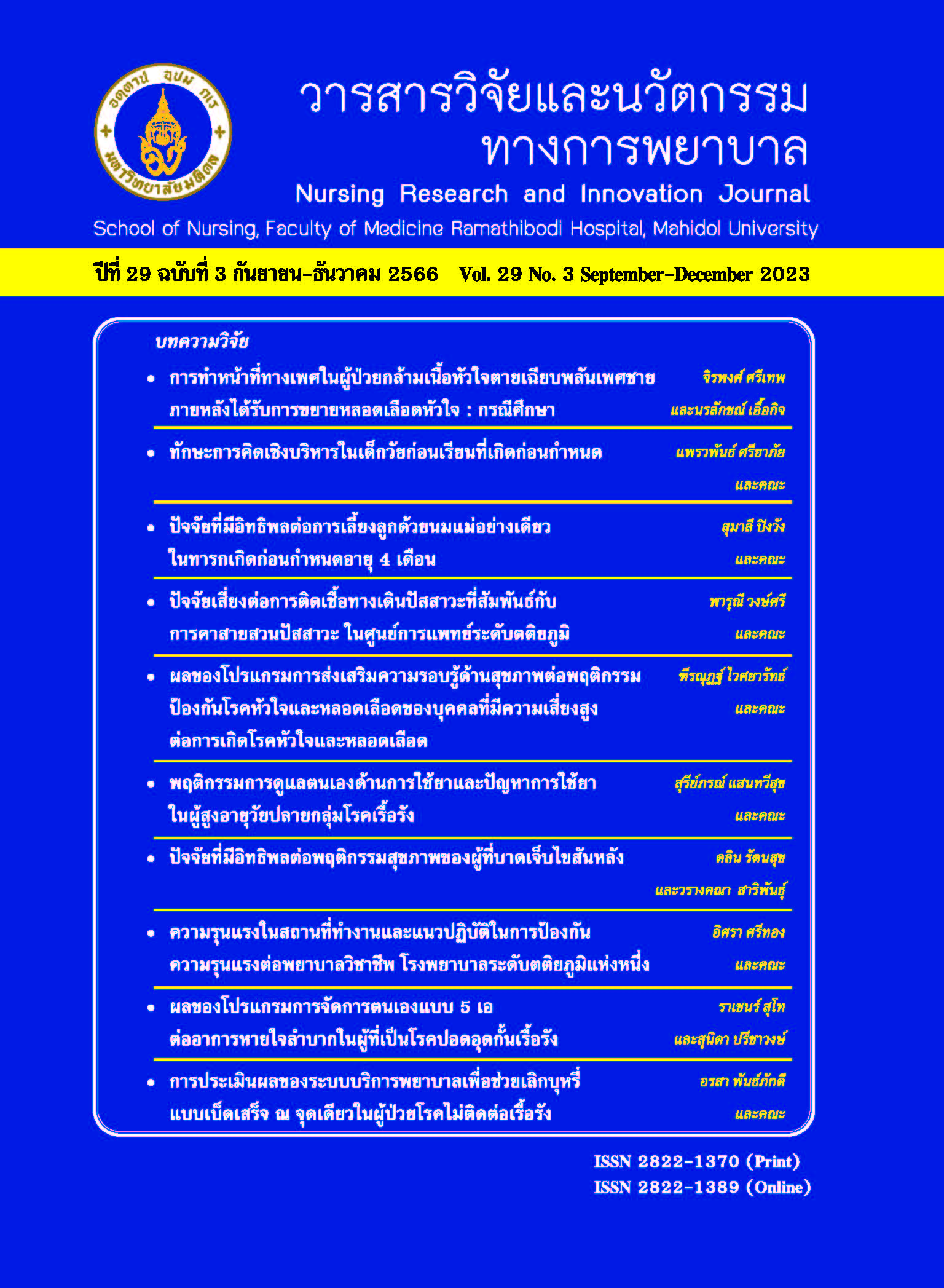Risk Factors of Catheter-Associated Urinary Tract Infection in a Tertiary-care Medical Center
Main Article Content
Abstract
This retrospective study aimed to identify the catheter-associated urinary tract infection rate and risk factors among patients admitted to a tertiary-care medical center in Bangkok.Participants included 994 patients with indwelling urinary catheters from October 1 to December 31, 2020. The research instruments comprised a personal information form and a urinary catheterization data collection form. Data were analyzed using descriptive statistics and logistic regression analysis. Results revealed that the catheter-associated urinary tract infection rate was 5.67 per 1,000 catheter days, 21.11 and 4.39 per 1,000 in private medical wards and the intensive care unit, respectively. The logistic regression analysis model revealed that factors predicting catheter-associated urinary tract infections were gender,heart failure, infection of other body parts,and urinary catheter days. These variables could jointly explain the variance in catheter-associated urinary tract infections by 39.20%.Participants with infection of other body parts had the risk of catheter-associated urinary tract infections 14.46 times significantly compared with those without infection when controlled for variables of gender,heart failure, and catheter days.Also, a 1-day increase in catheter days significantly increased the risk of catheter-associated urinary tract infections by 7% after controlling for other variables. Therefore, healthcare professionals should closely monitor patients requiring long-term indwelling urinary catheters and infections of other body parts. Re-evaluating the reasons for indwelling urinary catheters is necessary to reduce the riskof catheter-associated urinary tract infections.
Keywords: Indwelling urinary catheter, Infection rate, Risk factors, Urinary tract infection
Article Details

This work is licensed under a Creative Commons Attribution-NonCommercial-NoDerivatives 4.0 International License.
บทความ ข้อมูล เนื้อหา รูปภาพ ฯลฯ ที่ได้รับการตีพิมพ์ในรามาธิบดีพยาบาลสาร ถือเป็นลิขสิทธิ์ของวารสาร หากบุคคลหรือหน่วยงานใดต้องการนำทั้งหมดหรือส่วนหนึ่งส่วนใดไปเผยแพร่หรือเพื่อกระทำการใด ใด จะต้องได้รับอนุญาตเป็นลายลักษณ์อักษรจากรามาธิบดีพยาบาลสารก่อนเท่านั้น
References
MohiuddinAK.Lifestyle issues and prevention of recurrent UTIs. Biomed J Sci Tech Res. 2019;21(3):15961-5. doi:10.26717/bjstr.2019.21.003618.
Septimus EJ, Moody J. Prevention of device-related healthcare - associated infections.F1000Res. 2016;5
Rhee C, Phelps ME, Meyer B, Reed WG. Viewing prevention of catheter-associated urinary tract infection as a system: using systems engineering and human factors engineering in a quality improvement project in an Academic Medical Center. Jt Comm J Qual Patient Saf.2016;42(10):447-71.
Faculty of Medicine Ramathibodi Hospital. Infection prevention and control service.Surveillance report 2018- 2020.Bangkok:Ramathibodi Hospital;2020.(inThai).
Chen H, Lee JWY, Yu KCH, Chan CKW, Wong ATY,LaiRWM,etal.Prevalence survey on catheter-associated urinary tract infection(CAUTI)in public hospitals in Hong Kong 2018. Infect Control Hosp Epidemiol.2020;41(3):365-8.
Hollenbeak CS, Schilling AL. The attributable cost of catheter-associated urinary tract infections in the United States: a systematic review. Am J Infect Control.2018;46(7):751-7.
Unahalekhaka A. L-a-pS, Chitreecheur J,.Prevention of multidrug resistant organism infections in intensive care units; 2557 Available from Health System Research Institute web site: https://kb.hsri.or.th/dspace/handle/11228/4265?locale-attribute=th. (in Thai)
Letica-Kriegel AS, Salmasian H, Vawdrey DK,Youngerman BE,Green RA,Furuya EY,etal.Identifying the risk factors for catheter-associated urinary tract infections: a large cross-sectional study of six hospitals.BMJ Open. 2019;9(2):e022137.
Eliakim-Raz N, Babitch T,Shaw E, AddyI, WiegandI,Vank C, et al. Risk factors for treatment failure and mortality among hospitalized patients with complicated urinary tract infection: a multicenter retrospective cohort study (RESCUING Study Group). Clin Infect Dis.
;68(1):29-36.
LiF,Song M, Xu L, Deng B, ZhuS, Li X. Risk factors for catheter-associated urinary tract infection among hospitalized patients: a systematic review and meta-analysis of observational studies. J Adv Nurs.2019;75(3):517-27.
Dudeck MA, Horan TC,Peterson KD, Allen-Bridson K,Morrell G, Anttila A, et al. National healthcare safety network report,data summary for 2011,device-associated module. Am J Infect Control. 2013;41(4):286-300.
Flores-Mireles AL,WalkerJN, Caparon M, Hultgren SJ.Urinary tract infections: epidemiology, mechanisms of infection and treatment options. Nat Rev Microbiol.2015;13(5):269-84.
Werneburg GT. Catheter-associated urinary tract infections: current challenges and future prospects. Res Rep Urol. 2022;14:109-33.
Daniel WW. The Fisher exact test. Daniel WW.Biostatistics: a foundation for analysis in the health sciences. 7thed. New York:John Wiley and Sons; 1999.p.606-11.
Bujang MA, Sa’at N, Sidik T, Joo LC. Sample size guidelines for logistic regression from observational studies with large population: emphasis on the accuracy between statistics and parameters based on real life clinical tata.Malays J MedSci. 2018;25(4):122-30.
Bursac Z, Gauss CH, Williams DK, Hosmer DW.Purposeful selection of variables in logistic regression.Source Code Biol Med. 2008;3(1):17.
Anothayanonth Y. Factors that affecting catheter-associated urinary tract infection in tertiary hospital. J Police Nurs [Internet]. 2020 Jun. 16 [cited 2022 Sep.28];12(1):48-57. Available from: https://he01.tcithaijo.org/index.php/policenurse/article/view/240088.
(in Thai)
Barchitta M, Maugeri A,Favara G, RielaPM, La Mastra C, La Rosa MC, et al. Cluster analysis identifies patients at risk of catheter-associated urinary tract infections in intensive care units:findings from the SPIN-UTI Network.J HospInfect. 2021;107:57-63.
Anggi A, Wijaya DW, Ramayani OR. Risk factors for catheter-associated urinary tract infection and uropathogen bacterial profile in the intensive care unit in hospitals in Medan, Indonesia. Open Access Maced J Med Sci.2019;7(20):3488-92.
Leelakrishna P KRB. A study of risk factors for catheter associated urinary tract infection. Int J Adv Med.2018;5(2):334-9.
Shuman EK, Chenoweth CE. Recognition and prevention of healthcare-associated urinary tract infections in the intensive care unit. Crit Care Med. 2010;38(8Suppl):S373-9.
Association for Professionals in Infection Control and Epidemiology. Guide to preventing catheter-associated urinary tract infections (CAUTIs). [database on the Internet]. [cited 2022 Feb 10]. Available from:https://apic.org.
Farsi AH. Risk factors and outcomes of postoperative catheter-associated urinary tract infection in colorectal surgery patients: a retrospective cohort study. Cureus.2021;13(5):e15111.
GillenJR, Isbell JM,Michaels AD, Lau CL,Sawyer RG.Risk factors for urinary tract infections in cardiac surgical patients.SurgInfect (Larchmt). 2015;16(5):504-8.
RosserCJ,BareRL,MeredithJW.Urinary tract infections in the critically ill patient with a urinary catheter. Am J Surg. 1999;177(4):287-90.
Vincitorio D, BarbadoroP,Pennacchietti L,Pellegrini I,David S, Ponzio E, et al. Risk factors for catheter-associated urinary tract infection in Italian elderly. Am J Infect Control. 2014;42(8):898-901.
Kakaria BA AK, Tushar R. Study of incidence and risk mfactors of urinary tract infection in catheterized patients admitted at tertiary care. Int J Res MedSci. 2018;6(5):tertiarycare. Int J Res MedSci. 2018;6(5):1730-3.
Alam J, Verma PK, Kala S, Rawat V. Incidence and microbiology of catheter associated urinary tract infection in hospitalized patients in a tertiary care hospital in Kumaon region. IJRR. 2020;7(5):114-17.


